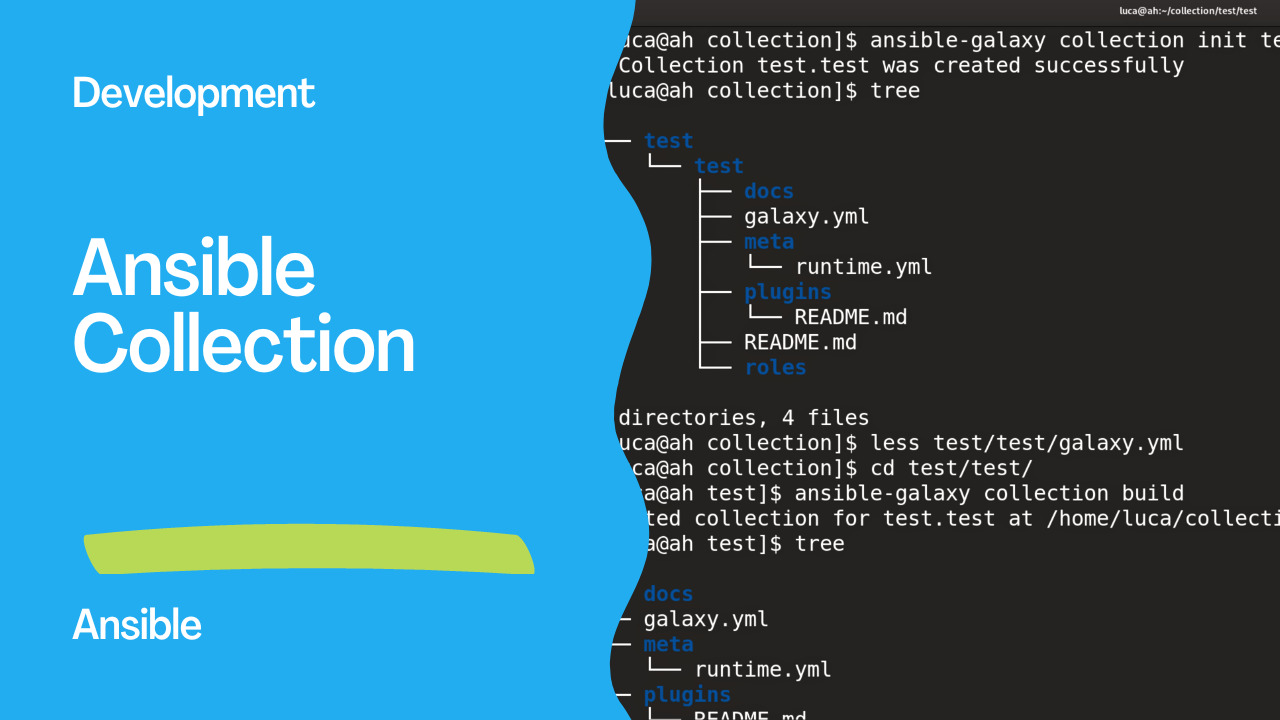Introduction
Ansible Collections are a powerful way to organize and distribute your Ansible content, including modules, plugins, roles, and more. They allow you to package and share your automation resources in a structured and reusable manner. In this tutorial, we’ll walk you through the process of creating a new Ansible Collection using the ansible-galaxy command-line tool.
Links

Step by step
Step 1: Installation and Prerequisites
Before you start, ensure that you have Ansible and the ansible-galaxy command-line tool installed on your system. If not, you can install Ansible by following the official documentation. Once installed, you’ll be ready to create your new Ansible Collection.
Step 2: Initialize a New Collection To create a new collection, open your terminal and run the following command:
ansible-galaxy collection init test.test
This command initializes a new collection named test.test. You should see an output confirming that the collection was created successfully.
ansible-galaxy collection init test.test
- Collection test.test was created successfully
Step 3: Explore the Collection Structure
After creating the collection, navigate to the collection’s directory. You can use the following command:
cd test/test
Inside this directory, you’ll find several subdirectories and files that make up your Ansible Collection’s structure:
docs/: This directory is where you can add documentation related to your collection.galaxy.yml: This file contains metadata about your collection, including its name, description, and author information.meta/: This directory stores files related to the metadata of your collection, such as the runtime configuration.plugins/: This directory is where you can add custom plugins.README.md: This file provides information about your collection and its usage.roles/: This directory is where you can add roles specific to your collection.
Content of the “test/test” directory:
.
└── test
└── test
├── docs
├── galaxy.yml
├── meta
│ └── runtime.yml
├── plugins
│ └── README.md
├── README.md
└── roles
6 directories, 4 files
Step 4: Making Necessary Changes
At this point, you can start making the necessary changes to your collection. You can add new modules, plugins, roles, or any other content your automation requires. Modify the galaxy.yml file to reflect your collection’s information accurately.
Step 5: Building the Collection It’s time to build the collection once you’ve made the required changes and added your content. Building the collection packages all your content into a distributable archive. In your collection’s directory, run the following command:
ansible-galaxy collection build
This command will create a compressed archive file named after your collection and version, such as test-test-1.0.0.tar.gz.
Created collection for test.test at /home/luca/collection/test/test/test-test-1.0.0.tar.gz
Step 6: Verifying the Build After running the build command, you’ll find the archive file in your current directory. You can verify its contents using the following commands:
file test-test-1.0.0.tar.gz
du -hs test-test-1.0.0.tar.gz
tar -tvf test-test-1.0.0.tar.gz
These commands will display information about the archive file, including its size, compression type, and the contents it contains.
$ file test-test-1.0.0.tar.gz
test-test-1.0.0.tar.gz: gzip compressed data, was "test-test-1.0.0.tar", last modified: Wed Aug 9 14:56:25 2023, max compression, original size modulo 2^32 20480
$ du -hs test-test-1.0.0.tar.gz
4.0K test-test-1.0.0.tar.gz
Content of the “test-test-1.0.0.tar.gz” archive:
-rw-r--r-- 0/0 714 2023-08-09 15:56 MANIFEST.json
-rw-r--r-- 0/0 1159 2023-08-09 15:56 FILES.json
-rw-r--r-- 0/0 68 2023-08-09 15:55 README.md
drwxr-xr-x 0/0 0 2023-08-09 15:55 docs/
drwxr-xr-x 0/0 0 2023-08-09 15:55 meta/
-rw-r--r-- 0/0 1374 2023-08-09 15:55 meta/runtime.yml
drwxr-xr-x 0/0 0 2023-08-09 15:55 plugins/
-rw-r--r-- 0/0 963 2023-08-09 15:55 plugins/README.md
Conclusion
Congratulations! You’ve successfully created a new Ansible Collection named test.test and built an archive ready for distribution. You can now share or use your collection on Ansible Galaxy and Automation Hub in your automation projects. Creating and managing Ansible Collections empowers you to efficiently organize and distribute your automation resources, making it easier for you and others to leverage your automation efforts.
Subscribe to the YouTube channel, Medium, and Website, X (formerly Twitter) to not miss the next episode of the Ansible Pilot.
Academy
Learn the Ansible automation technology with some real-life examples in my
Udemy 300+ Lessons Video Course.

My book Ansible By Examples: 200+ Automation Examples For Linux and Windows System Administrator and DevOps

Donate
Want to keep this project going? Please donate
